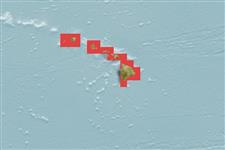Hexacorallia |
Scleractinia |
Acroporidae
Environment: milieu / climate zone / تغييرات عمق / distribution range
بوم شناسي
وابسته به آب سنگ. Tropical; 23°N - 18°N, 161°W - 154°W (مرجع 846)
Indo-Pacific: Mozambique, Hawaii, and USA.
Length at first maturity / Size / Weight / سن
بلوغ: Lm ? range ? - ? cm Max length : 0.1 cm CORD جنس نر / بدون خواص جنسي; (مرجع 846)
Colonies: encrusting; with irregular lobes. Corallites: small; 0.05 cm diameter. Papillae; cover the colony; sometimes fused into ridges. Septa: poorly developed (Ref. 846).
Shallow reef environments (Ref. 846).
Life cycle and mating behavior
بلوغ | تولید مثل | تخم ریزی | Eggs | Fecundity | Larvae
Members of the class Anthozoa are either gonochoric or hermaphroditic. Mature gametes are shed into the coelenteron and spawned through the mouth. Life cycle: The zygote develops into a planktonic planula larva. Metamorphosis begins with early morphogenesis of tentacles, septa and pharynx before larval settlement on the aboral end.
مآخذ اصلی
مراجع | هماهنگ كننده | همكاران
Veron, J.E.N. 2000 Corals of the world. Volume 1. Australian Institute of Marine Science and CRR Qld. Pty. Ltd. Australia. 463 p. (مرجع 846)
وضعيت در فهرست قرمز IUCN
(مرجع 130435: Version 2025-1)
وضعيت از نظر سايتس (مرجع 108899)
Not Evaluated
خطر برای انسان ها
Harmless
استفاده انسانی
| FishSource |
ابزارها
اطلاعات بيشتر
Trophic EcologyFood items (preys)
تركيب غذايي
مصرف غذايي
شکارچیان
Population dynamicsرشد
Max. ages / sizes
Length-weight rel.
Length-length rel.
نوسانات طولی
Mass conversion
فراواني
Life cycleتولید مثلبلوغFecundityتخم ریزیEggsنمو تخمLarvae PhysiologyOxygen consumption
Human RelatedStamps, coins, misc.
منابع اينترنتي
Estimates based on models
Preferred temperature
(Ref.
115969): 25.1 - 25.6, mean 25.3 (based on 23 cells).
Fishing Vulnerability
Low vulnerability (10 of 100).
طبقه قيمت
Unknown.
